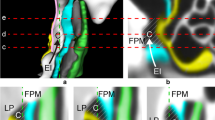Abstract
Background
A variety of lesions can affect the orbit. Surgical approaches must be available to provide 360 degrees of access. For tumors occupying the superomedial intraconal quadrant, there is a rationale to selecting the medial orbito-frontal approach.
Methods
This article outlines the relevant surgical anatomy and the different surgical steps of this approach.
Results
The medial orbito-frontal approach offers a full exposure of the superomedial intraconal quadrant and avoids crossing the plane of the optic nerve.
Conclusion
In selected intraconal tumor cases, this transcranial epidural intraorbital approach is a straightforward corridor through reliable landmarks that can be routinely performed.



Similar content being viewed by others
Abbreviations
- CN,:
-
cranial nerve
- CSF,:
-
cerebro-spinal fluid
- ON,:
-
optic nerve
- SOF,:
-
superior orbital fissure
References
Aviv RI, Casselman J (2005) Orbital imaging : Part 1. Normal anatomy. ClinRadiol 60(3):279–287
Aviv RI, Miszkiel K (2005) Orbital imaging: Part 2. Intraorbital pathology. ClinRadiol 60(3):288–307
DeMonte F, Tabrizi P, Culpepper SA, Suki D, Soparkar CN, Patrinely JR (2002) Ophthalmological outcome after orbital entry during anterior and anterolateral skull base surgery. J Neurosurg 97:851–858
Rhoton AL Jr (2002) The orbit. Neurosurgery 51(4 Suppl):S303–S334
Schick U, Dott U, Hassler W (2003) Surgical treatment of orbital cavernomas. Surg Neurol 60(3):234–244
Author information
Authors and Affiliations
Corresponding author
Ethics declarations
Conflict of interest
None of the authors disclose any conflict of interest or any financial disclosure in relation with this study. The manuscript has not been previously published in whole or in part or submitted elsewhere for review.
Informed consent
The patient consented to submission of this How I Do It to the journal.
Electronic supplementary material
ESM 1
Video: Medial orbito-frontal approach: The frontal bone flap was shaped behind the supraorbital rim. A transcranial epidural intraorbital approach was performed through an osteoclastically 2 × 2-cm orbital roof window. Incision of the periorbita exposed the frontal nerve. Dissection was directed through the space between the superior oblique muscle and the levator, according to the superomedial position of this intraconal mass. The surface of an indurated purple mass was seen in depth, typical of a hemangioma. Due to its solid texture and adhesion to the orbital fat, the tumor mass was removed in a one-piece fashion. The periorbita was repaired with a dural patch and maintained with fibrin glue. (MP4 109,419 kb)
Rights and permissions
About this article
Cite this article
Troude, L., Bernard, F. & Roche, PH. The medial orbito-frontal approach for orbital tumors: a How I Do It. Acta Neurochir 159, 2223–2227 (2017). https://doi.org/10.1007/s00701-017-3319-5
Received:
Accepted:
Published:
Issue Date:
DOI: https://doi.org/10.1007/s00701-017-3319-5




